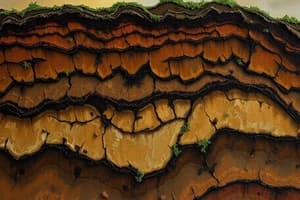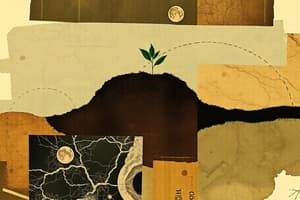Podcast
Questions and Answers
Which zone is associated with earthquakes due to the collision of continental plates?
Which zone is associated with earthquakes due to the collision of continental plates?
- Mediterranean and Trans-Asiatic Zone (correct)
- Circum-Pacific Zone
- African Rift System
- Mid-Oceanic Ridges
What does the Richter scale measure?
What does the Richter scale measure?
- The intensity of an earthquake
- The frequency of earthquake occurrences
- The absolute energy released in an earthquake (correct)
- The magnitude of seismic waves
Which of the following statements is true regarding seismometers?
Which of the following statements is true regarding seismometers?
- Seismometers and seismographs are entirely different instruments.
- They provide graphical output known as a seismogram. (correct)
- They only measure seismic waves from volcanic eruptions.
- They are limited to measuring earthquakes only.
Which seismic zone is characterized by earthquakes with depths reaching 300 to 700 km below sea level?
Which seismic zone is characterized by earthquakes with depths reaching 300 to 700 km below sea level?
How is the intensity of an earthquake represented by the Mercalli Scale?
How is the intensity of an earthquake represented by the Mercalli Scale?
Which of the following best describes the location of alluvial soils in India?
Which of the following best describes the location of alluvial soils in India?
What are the two types of alluvial soils found in the Upper and Middle Ganga plain?
What are the two types of alluvial soils found in the Upper and Middle Ganga plain?
What characterizes Khadar soils in relation to their deposition?
What characterizes Khadar soils in relation to their deposition?
Which agency is responsible for the comprehensive studies of soils in India?
Which agency is responsible for the comprehensive studies of soils in India?
What is the predominant feature of Bhangar soils?
What is the predominant feature of Bhangar soils?
Flashcards are hidden until you start studying
Study Notes
Soil Horizons and Classification in India
- A horizon sits above the C horizon and includes soils formed on various substrates such as sand dunes and volcanic materials.
- Various agencies, including the Soil Survey of India (1956), have conducted comprehensive soil surveys post-Independence.
- The Indian Council of Agricultural Research (ICAR) classified Indian soils based on USDA Soil Taxonomy.
- Indian soils are classified into categories like Alluvial, Black, Red and Yellow, Laterite, Arid, Saline, Peaty, and Forest soils.
Alluvial Soils
- Alluvial soils cover approximately 40% of India, primarily located in northern plains and river valleys.
- These are depositional soils transported and deposited by water bodies.
- In Rajasthan, they extend to Gujarat, and they are also found in peninsular deltas and river valleys.
- In the Ganga plain, alluvial soils divide into Khadar (new alluvium deposited annually by floods) and Bhangar (older alluvium).
- Khadar is enriched by annual floods while Bhangar is located further from floodplains.
- Both Khadar and Bhangar contain calcareous concretions known as Kankars.
Earthquake Measurement
- Seismometers measure ground motion caused by seismic waves from earthquakes and volcanic eruptions.
- Seismographs, an older term for seismometers, record seismic activity, producing a seismogram.
- The Mercalli Scale measures earthquake intensity based on observed effects, ranging from 1 to 12.
- The Richter Scale quantifies earthquake magnitude, with each whole number indicating a tenfold increase in power.
Earthquake Zones
- Circum-Pacific Zone: Predominantly features subducting oceanic plates with varying depths of earthquake foci (300-700 km).
- Mediterranean and Trans-Asiatic Zone: Characterized by shallow to intermediate earthquakes due to continental plate collisions.
- Mid-Oceanic Ridges and African Rift System: Experience shallow-focus earthquakes along ridges and rift zones.
- In India, four seismic zones are identified based on historical seismic activity: Zone II, III, IV, and V.
Theories on the Origin of the Universe
- Nebular Hypothesis: Proposed by Immanuel Kant and revised by Laplace, suggesting planets formed from a rotating cloud of material around a young sun.
- Planetesimal Hypothesis: In 1900 by Chamberlain and Moulton, positing a wandering star's proximity to the sun influenced planet formation.
- Binary Theories: Suggests a companion star to the sun existed alongside it during the formation of the solar system.
- Big Bang Theory: Introduced by Edwin Hubble, stating the universe began from a singular point around 15 billion years ago, resulting in an expanding universe and creation of galaxies, stars, and planets.
Studying That Suits You
Use AI to generate personalized quizzes and flashcards to suit your learning preferences.




